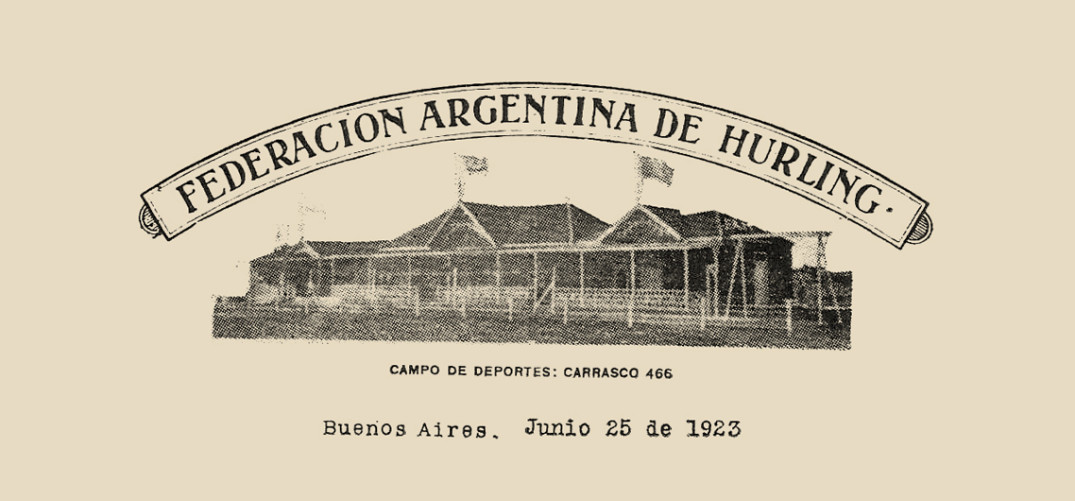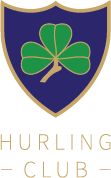HistoryHurling in Argentina
 The first record of hurling in Argentina is from 1887 and 1888, three to four years after the founding of the GAA, when Irish immigrants and those of Irish descent began playing the game in Mercedes and near the Passionist monastery of Saint Paul in Capitán Sarmiento. It is likely that the games being played were largely un-codified and not competitive in nature (King & Darby 2007: 430). No information exists as to the motivation of the first players of hurling or their country of origin. It was not until May 1900 that the first attempts were made at organising and promoting the game when an exhibition game was played in the lands of the Irish Catholic Association in the district of Caballito, which is now a public square known as Plaza Irlanda. It would appear that the key instigator was William Bulfin (1864-1910) of Birr, County Offaly, who was editor of the weekly newspaper for the Irish community, The Southern Cross, which became an important organ for promoting the game. Indeed over the course of the early 1900s there were many articles explaining the rules and nuances of hurling.
The first record of hurling in Argentina is from 1887 and 1888, three to four years after the founding of the GAA, when Irish immigrants and those of Irish descent began playing the game in Mercedes and near the Passionist monastery of Saint Paul in Capitán Sarmiento. It is likely that the games being played were largely un-codified and not competitive in nature (King & Darby 2007: 430). No information exists as to the motivation of the first players of hurling or their country of origin. It was not until May 1900 that the first attempts were made at organising and promoting the game when an exhibition game was played in the lands of the Irish Catholic Association in the district of Caballito, which is now a public square known as Plaza Irlanda. It would appear that the key instigator was William Bulfin (1864-1910) of Birr, County Offaly, who was editor of the weekly newspaper for the Irish community, The Southern Cross, which became an important organ for promoting the game. Indeed over the course of the early 1900s there were many articles explaining the rules and nuances of hurling.
The first ‘official’ match took place in July of the same year, between teams from two districts of the city of Buenos Aires, Palermo and Almagro, though the game had to be limited to nine players per team, rather than the usual seventeen, due to the shortage of hurleys. The following month the Buenos Aires Hurling Club was established with James Patrick Harte (d. 1932) of County Cork elected as its first president. For all intents and purposes it was to ‘be institutionally and officially a branch of the GAA’ (King & Darby 2007: 431). Games were played most weekends and received good coverage in the local press including the Argentine daily, La Nación.
Generally those that played hurling in the early days were urban middle-class workers who had settled in the western districts of the city of Buenos Aires, principally Villa Devoto, Belgrano, Flores and Caballito, and worked for such firms as Swift, Agar Cross, Duperial, and the railroads, or were clerks for the insurance companies and banks. In the rural areas it tended to be more popular among labourers rather than landed Irish-Argentines. Not only was the game likely to appeal to these social groups, but it was also heavily promoted by the Roman Catholic Church as a way of nurturing identity and ensuring the preservation of religious adherence in a social and commercial environment dominated by Protestantism.
Following the end of World War One, the importation of hurleys resumed and there was a revival of the sport. In August 1920, Miguel Ballesty (1876-1950) of Salto, son of County Westmeath immigrants, convened a meeting with delegates from four of the most prominent hurling clubs in the country: Buenos Aires Hurling Club, Mercedes, Bearna Baoghail and Wanderers. At the first meeting it was decided to create a commission, which subsequently became the Argentine Federation of Hurling, to examine the feasibility of renting, on a long-term basis, a dedicated space where the game could be played. Hitherto, hurling clubs had rented football fields and other sports fields on an ad-hoc basis. The first committee was formed by Miguel Ballesty (president); S. Farrell (secretary); Jack Dowling (treasurer); J. Clinton, P. Murtagh, P.J. O’Reilly, E. Ennis and M. Kennedy (committee members) .
Initially the committee rented the grounds of Club Singer, located at Alberdi 400 in the district of Boedo, which was accessible by the new metro. On 21 October 1921 a special game was played in Mercedes in honor of Laurence Ginnell, diplomatic envoy of the Irish Republic who was visiting the country. Another game that would go down in the folklore of the club took place on 8 October 1922 between Irishborn players and another composed of Irish- Argentines in which the Irish-Argentines convincingly defeated their opponents (The Southern Cross 1975:58). The game itself was a re-run of another game that was played in 1914 just before the outbreak of World War One.
A short time afterwards the committee moved to the sports grounds of Banco Nación in the neighbourhood of Floresta, acquiring a longer lease. The site was redeveloped and two hurling pitches and tennis courts were built, as well as a wooden clubhouse, painted in the colours of the Irish flag: green, white and orange. Other sports played there included pelota a paleta and bochas (a type of boules). It was inaugurated on 15 August 1922 and a week later on 27 August 1922, the Argentine Federation of Hurling, the forerunner of the modern Hurling club, was founded.
After only twenty months at the Banco Nación site, the Argentine Federation of Hurling was to move again when in April 1924, they had to vacate the site due to a road building scheme. A new ground was located in the western district of Villa Devoto, located near the intersection of Santo Tomé and Sanabria streets. Although the original intention was to buy the site, Miguel Ballesty could not convince the other committee members to agree. Some felt the ground was too remote from a transportation perspective and the area was underdeveloped, whilst others felt that it was more prudent to continue renting. Finally, it was decided to rent part of the land. In front of a large audience in Villa Devoto on 13 July 1924 the grounds were opened and blessed by Monsignor Santiago Ussher. The inaugural match was between Capilla Boys and Saint Patrick’s Alumni.
Some of the clubs that played hurling during the early days of the new Argentine Federation of Hurling were: Buenos Aires Hurling Club, Mercedes, Wanderers, Bearna Baoghail, La Plata Gaels, Almirante Brown Capilla Boys, Saint Patrick’s Alumni, Saint Patrick’s Mercedes, Fahy Boys, St. Pauls, Irish Argentines, Juniors, New Lads, Santos Lugares, Club Nacional and Belgrano. There was to be a strong influence from the Catholic Church and many teams had in their ranks priests or students of the Pallotine or Passionist religious orders, who had either come from Ireland or were of Irish-Argentine descent.
